HISTORICAL MINIATURES JOURNAL ISSUE NUMBER 16
PUBLISHED
BY GEORGE GRASSE
BRITISH CAVALRY AT WATERLOO
MODELING 54mm
HISTOREX KITS, Part 2: 13th LIGHT DRAGOON REGIMENT
SERVICE RECORD SUMMARY AT WATERLOO
The 13th Light Dragoons and the 3rd Hussars of the King's
German Legion made up the 7th Cavalry Brigade commanded by Colonel Sir F.
Arenschildt, K.C.B. The brigade was initially deployed along with the
Dutch-Belgian cavalry brigades of Merlen and Trip of de Collaert's Dutch-Belgian
Cavalry Division all in the center of the Allied line supporting Ponsonby's 2nd
or Union Cavalry brigade (1st Royals, 2nd Scots Greys, and 6th Inniskillings).
The 13th had three squadrons with 28 officers and 428
other ranks under arms at the Battle of Waterloo. It lost at Waterloo 11
killed, 69 wounded, and 19 missing for a total of 99 casualties. The 3rd
KGL Hussars had four squadrons with 35 officers and 840 other ranks under arms
that day and lost 40 killed, 70 wounded, 8 missing for a total of 118
casualties. Brigade total was 63 officers and 1,268 other ranks for a
grand total of 1,331 troops.
UNIFORM DESCRIBED
One of the oddities of British light cavalry is the official naming of
all regiments as light dragoons including the hussar regiments whose dress was
substantially different and followed the European norm for hussar cavalry.
The 7th Hussar Regiment will be covered in the next issue. British light
dragoons proper, underwent a uniform change before Waterloo and adopted one that
closely resembled French Chasseurs a cheval. The short dark blue jacket
had short tails which were turned back. Individual regimental facing
colors were applied to the turnbacks, collar, pointed cuffs, and lapels.
In the case of the 13th Light Dragoons, the facing color was buff. Some
regiments had yellow lace (gold for officers) and others had white lace (silver
for officers). The jacket was wrapped by a girdle (cumberbund) in the
facing color (buff for the 13th) with two horizontal dark blue stripes. At
the back of the jacket, piping in the facing color appeared on the back of each
arm over to each shoulder blade and down to the runbacks. Coat tail
pockets were piped in the facing color. Each shoulder was covered by a
white fringed epaulette. All metal buttons white pewter (silver for
officers).
Campaign trousers were gray with a leather insert and yellow stripes along
each outer seam. The shako was black with a white band around the
top edge and surmounted by a white over red pompom. Shako chin scales were
brass. The cap line was yellow. The cockade was white with a black
center held in place by a white cockade strap and white metal button.
Equipment was as for all British cavalry lf the line. White pouch belt,
black cartridge box and white carbine belt. Off white to light beige-gray
haversack. Blue canteen with red-brown strap. The two-sling
sabretache was black without ornamentation. White sword belt and slings
supporting a steel scabbard and sword with a steel guard.
This model is built from an old Historex kit HXHI08 which has been renumbered
to HXH007.
MODELING
A TROOPER OF THE 13th
light dragoon REGIMENT
| Figure 1
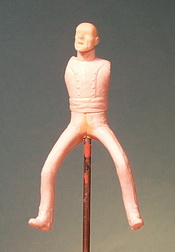 |
Figure 1 at left shows the basic assembly in starting this figure.
The mounted trooper of the British 13th Light Dragoons is made from Historex kit
HXH007 which includes parts to make an enlisted soldier. I substituted the
kit's head with one from MIG Productions. Doing this required that a lead
foil collar be made to wrap around the neck.
Figure 2 at right shows the horse to be used in this project.
The first step is to glue all of the components in place: horse body halves,
head, mane, forelock, tail, and ears. After filling and sanding, the
Pyrogravure tool is used to enhance hair lines on the forelock, mane, tops of
hooves, and tail (click
here for my article on this tool). Next are added the breast harness, girth
strap, and crupper, all made from sheet lead stock. Two horseshoes from
the kit were added where they will be seen. The horse is then primed,
mounted on its plastic base which in turn is mounted on its wood display base.
|
Figure
2  |
|
Figure 3a
 |
Figure 3a - front view with trooper's equipment and
belting in place. All belts are made from thin lead sheet.
Stirrup straps are also made from thin lead sheet, looped through
the top of the stirrup, then glued to the inside of the legs.
The small plastic bits on the straps are kit parts that represent
the excess strap rolled up and secured.
Figure 3b - rear view of the
trooper showing placement of the canteen and cartridge box.
The carbine sling will be bent down so the carbine sprung hook falls
more naturally straight down. The trooper's head is taken from
MIG Productions pack of Bald Heads No. 1. The back of the head
is built up with putty so the shako will fit more naturally.
The putty is cut with an X-Acto knife blade so it looks like hair.
|
Figure 3b
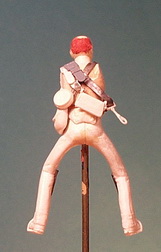 |
|
Figure 4a
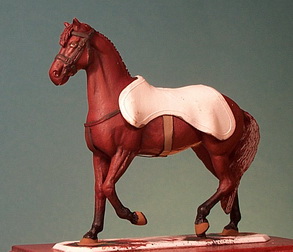 |
Figure 4a shows the horse after
painting using artist's oils. Horse hair will be applied in a
later step. All harnesses have been painted with Vallejo
VC0941 Burnt Umber and will serve as the outline for the light brown
harnesses. The girth strap is Vallejo VC0884 Stone Grey.
This horse will be a dark bay which is why the lower part of the
legs are black. Hooves a mixture of Vallejo VC0950 Flat Black
and VC0981 Orange Ochre. British light cavalry horse equipment
featured a cloth shabraque with rounded corners.
|
|
|
|
Figure 4b at right shows the completed saddle with
round portmanteau. The sheepskin saddle cover is first painted
Vallejo VC0951 Flat White then stained with my "off-white" mix and
highlighted with white. The harnesses have a final coat of
paint to represent the light brown color of British leather.
This is a two-thirds mix of Vallejo VC0981 Orange Ochre and
one-third VC0913 Yellow Ochre. Monograms supplied in the kit
were tediously glued to the cloth shabraque. The portmanteau
round ends were separate pieces with raised monogram detail.
The 13th Light Dragoons' facing color was buff which was applied
using Vallejo VC0976 Buff to the wide band around the cloth
shabraque, lettering, portmanteau ends, and the festooning around
the edge of the sheepskin saddle cover. Horsehair is painted
with my mix of semi-gloss black. Horseshoes are painted with
Vallejo VC0864 Natural Steel.
|
Figure 4b
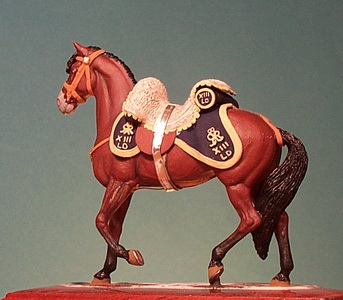 |
|
Figure 5a
 |
Figures 5a (left) and 5b (right) - painting of the
figure has been started by setting the shako and its chinscales in
place all painted flat black. The white band around the top
will be overpainted with yellow later on - the white serves as a
good foundation base for the yellow. Chinscales are painted
Vallejo VC0801 Brass. The lower rim of the shako, the visor,
and top (not visible) are painted semi-gloss black. The jacket
is painted in my mix of French Dark Blue. Facings on the
cuffs, collar, lapels, and turnbacks are Vallejo VC0986 Buff.
The canteen is Andrea ANAC51 Union Blue and its straps are Andrea
ANAC42 Brown Leather. The haversack and its strap is my mix of
Off White (30% Vallejo VC0988 Khaki and 70%VC0950 White).
|
Figure 5b
 |
|
Figure 6a
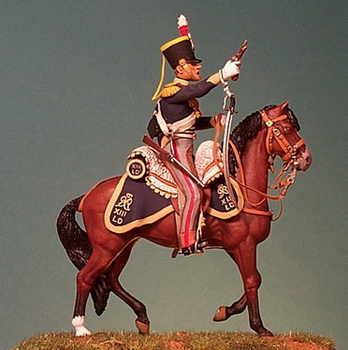 |
Figure 6a is the right side of
the completed figure. The carbine is glued via its attachment
point to the spring-loaded hook already attached to the carbine
sling. The carbine wood stock is painted in Andrea ANAC17
Medium Brown and then given a coat of clear semi-gloss. Horse reins
were strips of lead sheet, primed, and painted in the mix described
in panel 4b, above. Vallejo AC0953 Flat Yellow was used to paint the
shako's top rim, the epaulettes, cap lines, and flounders.
The sword is attached to a lead
foil strip glued around the lower arm. In this pose, the
trooper is preparing to charge and will fire his pistol at close
range, throw it away, grab the sword, and melee. Cap lines in
yellow were made from No. 12 household copper wire strands, passed
under the right epaulette, looped and dropped again to attach to
flounders over the right chest.
|
|
|
|
Figure 6b at right is another view of the completed
figure to illustrate painting. In this view, the belting of
the sword and sabretache are shown. All were made from strips
of lead sheeting, primed, and painted in a mix of my Off White and
Vallejo VC0951Flat White. British light dragoon sabretaches
were plain and attached to the trooper's belt by two straps as
opposed to three straps seen on French cavalry.
Campaign trousers for the light dragoons differed
among the regiments. The 13th wore plain gray overalls painted
using Vallejo VC0870 Medium Sea Gray with light brown leather
inserts and cuffs painted in Vallejo VC0981 Orange Ochre washed with
Vallejo VC0941 Burnt Umber. The single red stripe is Vallejo
VC0947 Red. All horse harness fittings are VC0864
Natural Steel. The pose of a dangling sword and firing a
pistol or carbine was not uncommon. In this model, I imagined
that a squadron of the 13th Light Dragoons is preparing to charge.
When close enough, troopers would fire their pistols, throw them
away, grab the sword, and enter the melee swinging away.
|
Figure 6b
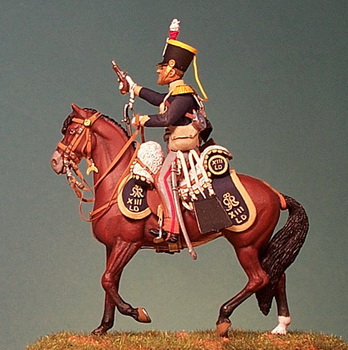 |
--------------------------------------------------------------------------------------------------------------------------------
.jpg)
****** FINIS ******
BIBLIOGRAPHY
Bowden, Scott. Armies at Waterloo. Arlington,
TX: Empire Game Press, 1983.
Fosten, Brian. Wellington's Light Cavalry,
Osprey Men-at-Arms No. 126. London, UK: Osprey Publishing Ltd., 1982.
Fosten, DSV and BK. The Thin Red Line, Plate No.
14, Light Dragoons 1815.
Hackbridge, Wallington, UK: Pimpernel Studios, 1986.
Pimlott, John. British Light Cavalry, Nations in
Arms 1800-1815. London, UK: Almark Publishing Ltd., 1977.
Wooten, Geoffrey. Waterloo 1815 - Osprey Campaign
Series No. 15. London, UK: Osprey Publishing Ltd, 1992.
GO TO?
© Copyright by George Grasse








.jpg)